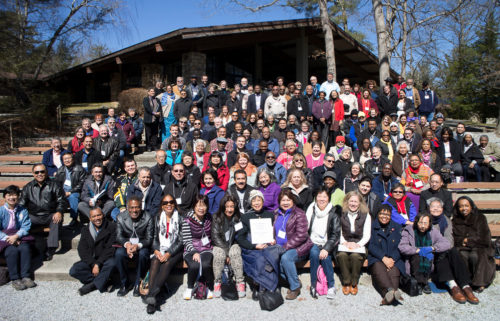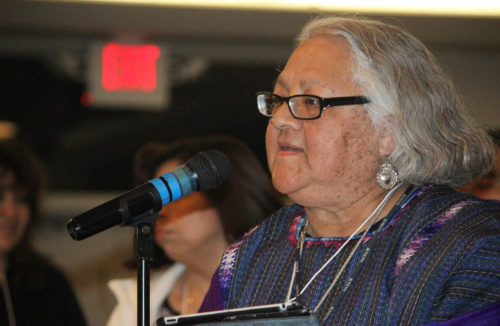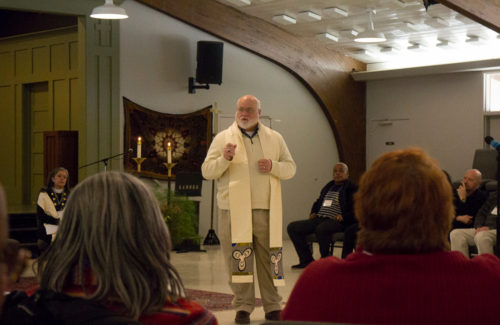New Community gathers ‘Together, Advancing the Sacred Dream’Posted Mar 17, 2014 |
|

About 200 clergy and laity from across the Episcopal Church gathered for the New Community gathering to “advance the sacred dream.” Photo: Lynn A. Collins
[Episcopal News Service] About 200 clergy and laity from across the Episcopal Church gathered to “set the vision quest” during the March 12-15 New Community Clergy and Lay Conference at the Kanuga Conference Center in Hendersonville, North Carolina.
Themed “Together, Advancing the Sacred Dream,” the second such gathering of ethnic ministries throughout the church was intended to move participants deeper into collaborative mission, partnership and relationship, according to Sarah Eagle Heart, Episcopal Church missioner for indigenous ministries.
“It was really important to us that we continue what we started during the first New Community gathering [in 2012 in San Diego],” Eagle Heart said while welcoming participants. “The Ogala Lakota talk about dreams in terms of vision quest … and we wanted to take all the dreams of our ancestors and of every ethnic group here and bring them together in one place.”
Eagle Heart and others invoked the spirit of the Rev. Terry Star, 40, who was to participate in the gathering, but died suddenly March 4 at Nashotah House Theological Seminary where he was a seminarian. He was described as a spirit of compassion, love and inclusion.
Citing the Lakota concept of mitakuye oyasin, or “we are all related,” during the opening Eucharist sermon, Isaiah Brokenleg called upon participants to “be good relatives to one another” and to relate to one another out of a mutual willingness to be vulnerable, honest and transparent.
Once we ask, “who are my relatives and what kind of relative do I want to be … we can work to be the change we want to see in our community,” he said.
Plenary and workshop presentations included: multiethnic church planting; asset-based community development; effective strategies for parish renewal; human trafficking; environmental and other forms of racism; and a session designed to elicit feedback for the Task Force for Reimagining the Episcopal Church.

Sarah Eagle Heart and Isaiah Brokenleg dance during an evening of cultural entertainment. Photo: Lynn A. Collins
‘Building the world we dream about’
Building the sacred dream and dismantling racism involves listening to “the stories we don’t know and learning the history we were not taught, even when it threatens the way we’ve always done things and our secret belief that assimilation is the goal,” according to the Rev. Gay Clark Jennings, president of the House of Deputies, during a March 13 panel discussion addressing issues of “white privilege, internationalized oppression, racial justice and reconciliation, and capacity building.”
It also involves broadening church responses to gender bias, homophobism, multiethnic people, interethnic discrimination and the complexities of culture, according to a consensus at the gathering.
Jennings acknowledged both benefiting from white privilege and “seeing the way my son is denied it.” Jennings adopted her son Sam from Colombia, and when he needed life-saving surgery at 4 months old, she recalled, “a church staff member said, ‘why don’t you just take him back and get a healthy white baby?’”
She said she hopes that both experiences have prompted her “to work for change from within the institutional church.”
For example, as deputies’ president, 30 percent of her appointments to churchwide committees, commissions, agencies and boards (CCABs) have been to people 40 or younger; 28 percent have been to people of color … “so we begin to change the face of those participating in churchwide bodies.”
Listening to and honoring each other’s stories to overcome “corporate amnesia” will not be easy, according to the Hon. Byron Rushing, a Massachusetts state representative and vice president of the House of Deputies, also a panelist.
He called instead for a corporate “anamnesis,” or remembering to remove the myth of slavery as an incidental occurrence in the early days of the European occupation of the Americas, to the truth of slavery as part of the origin of the nation and the Americas and the economic success of the United States.
“It means you’re asking people to change their understanding of what their relationship to other people can be, and their understanding of their right to the power they have,” he said. “There is no easy way to do it except to stand up and talk about it.”

Poet, visual artist and playwright Enedina Casarez Vasquez describes during a plenary session her search for Mexican cultural expressions and identity within the Episcopal Church. Photo: Lynn A. Collins
Visual artist, playwright, teacher and poet Enedina Casarez Vasquez shared experiences of growing up in Texas, a fifth generation Mexican-American who did not speak Spanish because “we were told it was a bad language and would keep us from becoming a success in life,” she said.
Feeling rejected by the Roman Catholic Church she joined the Episcopal Church, only to be disillusioned there, as well. “I want to see myself in the Episcopal Church,” she told the gathering. “I want to see priests and deacons that look like me, dark, brown, black, joyful. I want to see Mexican women as priests, to know they exist. Why do I not see them in my hometown? I know they exist somewhere outside of Texas [because] the United States is teeming with Latinos in the Episcopal Church.”
Still, she believes that the Episcopal Church is the answer, although “we need to look at the ugly stuff, and define reconciliation through dialogue,” she said.
The Rev. Jim Kodera, a Wellesley College professor of religion and rector of St. Luke’s Church in Hudson, Massachusetts, said he came to the United States as an international student and later became a naturalized citizen. He offered three “pernicious roots of racial prejudice,” including the belief that people on the receiving end of racism are homogenous, anonymous and strangers and foreigners.”
Kodera evoked laughter when he said the senior warden at his church had once said “I don’t think of you as Asian. I told her, I am. Please make the effort. In her mind she had already converted me into an Irish-American.”
But he added, “It’s easy to engage in anti-racism work as long as we think of racists to be out there. We do the same thing as we blame others … We have to stop that. It is much harder to acknowledge racism within ourselves and I would like to go as far as to suggest each one of us without exception is a racist in that we are all products of racist history and society.”
He added that, “in order to become a real Christian, you don’t have to become white. In order to become real Episcopalians, you don’t have to speak English. To become true disciples of Christ, all we have to do is follow in the footsteps of Christ in the context in which we belong.”
Seeds of the new community
The New Community gatherings grew out of frustration at the lack of diversity in worship and in the church’s CCABs, according to the Rev. Canon Anthony Guillen, who joined the Kanuga gathering via video link.
“It is something new developing … the new face of the church, diverse and multicultural and multilingual and rich and beautiful,” he said.
Advocacy, congregational development and bridgebuilding are at the heart of missioners’ work, according to the Rev. Fred Vergara, missioner for Asiamerica ministries, whose efforts are focused, among other things, on education and training and building a virtual classroom. The virtual classroom is designed for use in a theological exchange connecting the Episcopal Church with Asia and throughout the world, he said.
The Rev. Angela Ifill, missioner for black ministries, said people of African descent from the United States, Latin and South America, the Caribbean and the African continent, make up about 121,000, or 6.4 percent, of the Episcopal Church’s population.
Her New Visions Initiative partners congregations that have plateaued with stronger ones for mutual ministry and has sparked “changes from the bottom up rather than the top down,” she said. “We are all missionaries, we are all called into ministry and not just the ordained person, the people in the pews are also missioners and ministers of the church,” she said.
Opportunities for young people include the SOUL conference and the Rising Stars Initiative, which attempts to interrupt “the school to prison pipeline that pushes young children out of the classroom and into the prison system,” she said.
Indigenous Ministries Missioner Eagle Heart said she recognized immediately when she took the position five years ago that the need for healing “was so immense” among indigenous communities.
Her efforts include helping to offer opportunities for alternative theological and lay leadership, support for seminarians and providing discernment opportunities for young people of color. She described the Kanuga gathering as “an opportunity to work on the sacred dream” and to support one another.
Race and Poverty
The Rev. Jemonde Taylor described a 62-block area in Dallas that once “looked like a war zone.” For him, that area eventually became church, a spiritual community.
“There was nothing there except residents just barely hanging on. It was an opportunity to partner with others and to go into a community that was ready to be transformed.” It became known as Jubilee Park, a jubilee ministry, partnering with St. Michael and all Angels Church in Dallas in 1996.
Since the partnership began 15 years ago, crime has dropped by 65 percent, offers a variety of social services to about 5,000 weekly, and the local school – once considered among the worst – is now the highest performing elementary school in the Dallas Independent School District, Taylor told the gathering. “In my mind it is resurrection. A place that was dead is now living.”
Similarly, Marlene Whiterabbit Helgemo, a minister in the Evangelical Lutheran Church in America (ELCA), and pastor of All Nations Indian Church in Minneapolis, described “the legacy of manifest destiny” in terms of the staggering 70 percent high school dropout and 85 to 95 percent unemployment rates at the Pine Ridge Reservation in South Dakota.
The concept of manifest destiny – that belief that white settlers were superior to indigenous people – set in motion a domino effect that is still unfolding, Helgemo said.
Other grim statistics included 35 percent of homes having no electricity, more than 90 percent of the population living below U.S. federal poverty guidelines, and equally horrific health statistics, with cervical cancer rates five times the national level, more than half the population over 40 suffering from diabetes, and a life expectancy for men of 46 “roughly the same as Afghanistan and Somalia.”
“The last chapter in any successful genocide is the one in which the oppressor can remove their hands and say ‘my God what are these people doing to each other? They’re killing each other and themselves as we watch,” she said. “As removed as the dominant society may feel from a massacre in 1890 or a series of broken treaties 150 years ago, you have to ask the question how should you feel about the statistics of today, what is the connection between these images of suffering?”
“I’m from Pine Ridge,” Eagle Heart told the gathering. “These are my people … and knowing my own people and my own tribe and where I’m from, I’m struck sometimes by the hopelessness there. Jemonde [Taylor] shared that it’s really important to be there and with the people in prayer.”
Responding with loving service
The Rev. Ruben Duran, ELCA director for evangelizing congregations, said about 62 percent of his new congregational start-ups are among people of color whose language is not English and who are poor.
With 342 new congregations under development, he trains about 60 mission developers yearly, he said. “We would like the new community to grow, to be evangelical in their orientation to work for peace and justice as part of their DNA, a community that is always making new disciples, and looking for other opportunities to be able to grow the extension of God’s reign.”

Bishop Stacy Sauls, the Episcopal Church’s chief operating officer, addresses the gathering about the importance of being a missionary. Photo: Lynn A. Collins
Bishop Stacy Sauls, the Episcopal Church’s chief operating officer, also a panelist, said the church is attempting “to create a movement among young people in the Episcopal Church so that within a generation missionary service will be normative in the Episcopal Church.”
Paraphrasing Archbishop Emeritus of Cape Town Desmond Tutu, Sauls said that “we are all missionaries or we are nothing because that’s what it means to be a Christian, to be sent and to serve. There was a time in church when we forgot what that meant. We are determined to reclaim it.”
Now, being a missionary means “sending people to build relationships,” he added. “They are not the giver and somebody else the receiver, but the relationships are mutual in which Jesus is encountered. The strategy is to engage young people in the Episcopal Church, doubling the size of the Young Adult Service Corps.”
Environmental Racism
Presiding Bishop Katharine Jefferts Schori, during a panel discussion, said that environmental racism “is about domination both of human beings and the rest of creation, about human beings using others – both human others and nonhuman others – as objects. It is about a willingness to dump, seeing the rest of creation as a dumping ground or a resource to export.”
She added: “Our response has to be a move from confronting consumption as a way of being in this world, to conscious use of the rest of creation.” She cited as examples converting church land for food production and cultivating a consciousness about energy and water use and reducing, reusing, recycling.
The Rev. Canon Sandye Wilson, rector of the Episcopal Church of St. Andrew and Holy Communion in South Orange, New Jersey, said the state has 108 toxic waste centers – closest to the poorest cities – “breathing in horror, breathing out death.”
She said that African-American children are five times more likely to suffer from lead poisoning than their white counterparts “and so you become passionate about the reality of racism that is a part of how people live and how poor people have no idea when they move into community they’re setting themselves up for the possibility of death in the long run,” she said. “It’s incumbent upon us as the church to develop a passion for the interconnectedness of all of life; it is our responsibility to one another.”
Through a translator, the Rev. Luis Alberto Tuaza said he has worked for 30 years with indigenous people in the Diocese of Central Ecuador and, at the moment, “we’re fighting to avoid mining, preserve the forest, and to preserve the vegetation.” In addition to trying to protect the land, he also is trying to rescue the historical memory of the people, he said.
Sarah Augustine is co-director of Suriname Indigenous Health Fund, an international charity, and professor of sociology and director of student spirituality at Heritage University in Toppenish, Washington. She said that as institutions of faith, dioceses and congregations have the power to effect change by divesting financial holdings in large corporations “who are for destruction” and want to remove indigenous communities so they can mine for gold and other resources.
“We have to stop thinking of ourselves as consumers, and begin regarding ourselves as investors” and demand that companies abide by their own policies, she said. “This is our moment, this is happening here and now, we are the ones coming to save us; it’s us.”
Carrying the sacred dream
The sacred dream is “the ancient prophetic dream about what shalom looks like, what the reign of God looks like,” said the presiding bishop. “It is making it real in this day and our places, the kingdom of God on earth.”
“It is a dream of a world where love and justice reign,” added Vergara, missioner for Asiamerica ministries. “A dream of a church that carries forward missio Dei, the mission of God to reconcile all creation to unity with God and each other in Christ.”
For Guillen, “we hold the dream that someday indeed we will all be treated equally, that we will all have the same access. We won’t have the stereotypes and discrimination and all those other things. In the meantime, we celebrate the successes we’ve made, the strides we’ve made … There are still issues and there are still feelings and there’s still work to be done. So, we make strides, we work together, sometimes we have to be a little bit more vocal and proactive, but ultimately the dream is becoming a reality. But, it’s still a dream.”
Ifill, missioner for black ministries, agreed that “we are all fully integrated, fully involved, we have equal voice … and having equal voice, the vision of each person being considered, is the total dream of God. We’ve got a long, long, long way to go but we have hope and that’s what keeps us going.”
–The Rev. Pat McCaughan is a correspondent for the Episcopal News Service.


Social Menu